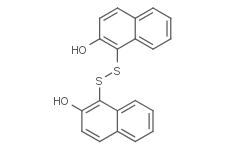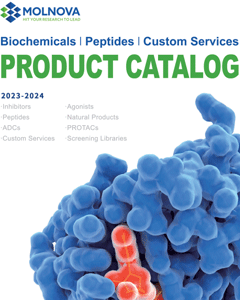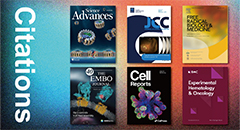
IPA-3
CAS No. 42521-82-4
IPA-3 ( IPA-3 | IPA 3 | IPA3 )
产品货号. M18540 CAS No. 42521-82-4
IPA-3 是一种选择性非 ATP 竞争性 Pak1 抑制剂,IC50 为 2.5 μM,对 II 组 PAK (PAK 4-6) 无抑制作用。
纯度: >98% (HPLC)
 COA
COA
 Datasheet
Datasheet
 HNMR
HNMR
 HPLC
HPLC
 MSDS
MSDS
 Handing Instructions
Handing Instructions
| 规格 | 价格/人民币 | 库存 | 数量 |
| 5MG | ¥316 | 有现货 |


|
| 10MG | ¥494 | 有现货 |


|
| 25MG | ¥956 | 有现货 |


|
| 50MG | ¥1742 | 有现货 |


|
| 100MG | ¥3070 | 有现货 |


|
| 200MG | 获取报价 | 有现货 |


|
| 500MG | 获取报价 | 有现货 |


|
| 1G | 获取报价 | 有现货 |


|
生物学信息
-
产品名称IPA-3
-
注意事项本公司产品仅用于科研实验,不得用于人体或动物的临床与诊断
-
产品简述IPA-3 是一种选择性非 ATP 竞争性 Pak1 抑制剂,IC50 为 2.5 μM,对 II 组 PAK (PAK 4-6) 无抑制作用。
-
产品描述IPA-3 is a potent and selective PAK1 inhibitor. IPA-3 inhibits the growth of liver cancer cells by suppressing PAK1 and NF-κB activation. IPA-3 treatment significantly inhibited the growth of HCC cells. The mechanisms through which IPA-3 treatment suppresses HCC cell growth are enhancement of apoptosis and blockage of activation of NF-κB. IPA-3 not only inhibits the HCC cell growth, but also suppresses the metastatic potential of HCC cells. Nude mouse xenograft assay demonstrated that IPA-3 treatment significantly reduced the tumor growth rate and decreased tumor volume, indicating that IPA-3 can suppress the in vivo tumor growth of HCC cells. Hepatocellular carcinoma (HCC) is one of the major malignancies worldwide and is associated with poor prognosis due to the high incidences of metastasis and tumor recurrence. Overexpression of p21-activated protein kinase 1 (PAK1) is frequently observed in HCC and is associated with a more aggressive tumor behavior, suggesting that PAK1 is a potential therapeutic target in HCC.
-
体外实验IPA-3 inhibits Pak1 activation in part by binding covalently to the regulatory domain of Pak1. IPA-3 binds Pak1 covalently in a time- and temperature-dependent manner. IPA-3 prevents binding of the Pak1 activator Cdc42. IPA-3 binds directly to the Pak1 autoregulatory domain. IPA-3 reversibly inhibits PMA-induced membrane ruffling in cells. IPA-3 (2 μM, 5 μM or 20 μM) reduces cell spreading in human primary Schwann and schwannoma cells. IPA-3 treatment significantly reduces the number of adherent Schwann and schwannoma cells in a dose-dependent manner. IPA-3 is a non ATP-competitive, allosteric inhibitor of p21-activated kinase 1 (Pak1). PIR3.5 is the control compound of IPA-3. IPA-3 prevents Cdc42-stimulated Pak1 autophosphorylation on Thr423. IPA-3 also prevents sphingosine-dependent Pak1 autophosphorylation. IPA-3 does not target exposed cysteine residues on Pak1. The disulfide bond of IPA-3 is critical for inhibition of Pak1 and in vitro reduction by the reducing agent dithiothreitol (DTT) abolishes Pak1 inhibition by IPA-3. IPA-3 inhibits activation of Pak1 by diverse activators, but does not inhibit preactivated Pak1. IPA-3 inhibits PDGF-stimulated Pak activation in mouse embryonic fibroblasts.
-
体内实验——
-
同义词IPA-3 | IPA 3 | IPA3
-
通路Others
-
靶点Other Targets
-
受体PAK1
-
研究领域Cancer
-
适应症——
化学信息
-
CAS Number42521-82-4
-
分子量350.45
-
分子式C20H14O2S2
-
纯度>98% (HPLC)
-
溶解度DMSO : ≥ 100 mg/mL 285.35 mM; H2O : < 0.1 mg/mL
-
SMILESOC1=CC=C2C=CC=CC2=C1SSC1=C2C=CC=CC2=CC=C1O
-
化学全称1,1'-disulfanediylbis(naphthalen-2-ol)
运输与储存
-
储存条件(-20℃)
-
运输条件With Ice Pack
-
稳定性≥ 2 years
参考文献
1. Deacon SW, et al. Chem Biol, 2008, 15(4), 322-331.
产品手册




关联产品
-
β- Amyloid (1-37)
β- Amyloid (1-37)
-
Dipsacussaponin C
The leaves of Turpinia arguya Seem.
-
Ethyl 3,4,5-trimetho...
Ethyl 3,4,5-trimethoxybenzoate is a natural product from Rauvolfia verticillata.



 021-51111890
021-51111890 购物车()
购物车()
 sales@molnova.cn
sales@molnova.cn







